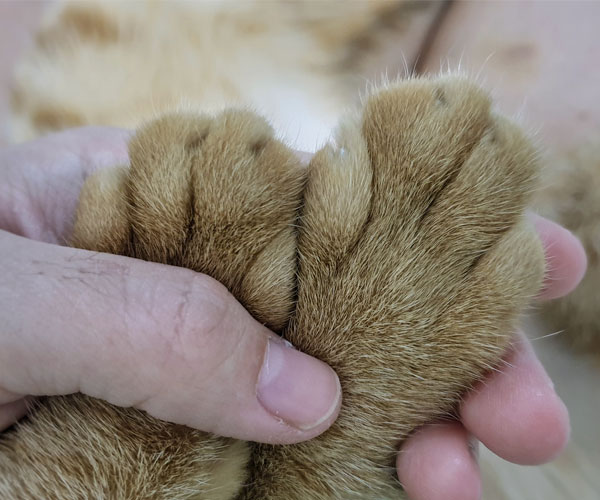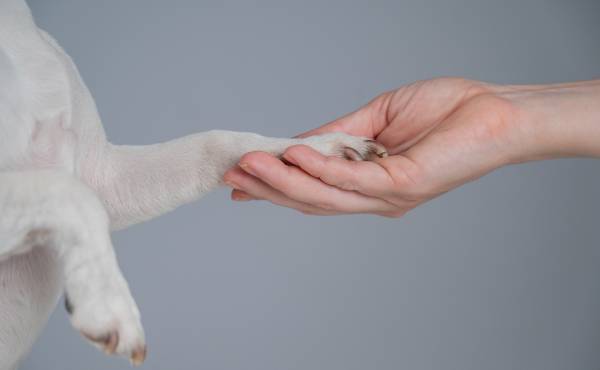Paw & Nail Disorders in Pets
Paw and nail disorders are common yet often overlooked causes of discomfort and pain in dogs and cats. Whether it’s chronic licking, limping, nail deformities, or infections, these issues can significantly affect your pet’s quality of life. Veterinary dermatologists specialize in diagnosing and treating a wide range of paw and nail conditions to help your pet stay active, comfortable, and healthy.
Common Paw Disorders
Pododermatitis (Inflammation of the Paws)
Pododermatitis is a general term for inflammation affecting the skin of the paws. It can cause:
- Redness, swelling, and tenderness
- Excessive licking or chewing of paws
- Cracked or bleeding skin between toes
- Secondary bacterial or fungal infections
Pododermatitis may be caused by allergies, irritants, infections, parasites, or autoimmune diseases.
Allergic Reactions Affecting the Paws
Pets with environmental or food allergies often develop itchy, inflamed paws as part of their overall allergic skin disease. Constant licking and chewing can worsen skin damage.
Infections and Abscesses
Cuts or puncture wounds on the paws can become infected, leading to painful abscesses that require veterinary care.
Foreign Bodies
Thorns, grass awns, or splinters lodged in the paw can cause persistent pain and inflammation.
Common Nail Disorders
Nail Bed Infections (Onychitis)
Infections of the nail bed can cause swelling, redness, and pain around one or multiple nails. Pets may chew or lick the affected nails excessively.
Nail Abnormalities and Deformities
Nails may become brittle, cracked, or misshapen due to trauma, infections, or underlying diseases.
Autoimmune Nail Diseases
Conditions such as pemphigus or lichen planus can cause inflammation and destruction of the nail beds and surrounding skin.
Overgrown Nails and Nail Trauma
Neglecting nail care can lead to overgrown nails causing discomfort or injury. Trauma from nail breakage or improper trimming may lead to infections or chronic problems.

How Are Paw & Nail Disorders Diagnosed?
Accurate diagnosis requires a thorough examination by a veterinary dermatologist, often including:
- Physical examination: Inspecting the paws and nails for signs of inflammation, infection, or injury.
- Skin scrapings and cytology: Identifying bacterial, fungal, or parasitic infections.
- Allergy testing: Determining if allergies contribute to paw inflammation.
- Biopsy: In complex or chronic cases, skin or nail biopsies may be performed to diagnose autoimmune or neoplastic conditions.
- Imaging: X-rays may be necessary to evaluate nail bed or bone involvement in severe cases.
Treatment Options for Paw & Nail Disorders
Medical Treatments
- Antibiotics or antifungals: To treat bacterial or fungal infections.
- Anti-inflammatory medications: Steroids or other drugs to reduce inflammation and itching.
- Immunosuppressive drugs: For autoimmune nail diseases under specialist supervision.
Supportive Care
- Regular nail trimming: Prevents overgrowth and trauma.
- Protective booties or bandages: To protect irritated or injured paws during healing.
- Medicated shampoos and topical treatments: Help soothe irritated skin and control infections.
Addressing Underlying Causes
- Allergy management: Controlling allergies reduces paw licking and inflammation.
- Parasite control: Treating mites or fleas that may cause irritation.
- Removing foreign bodies: Careful extraction to prevent chronic inflammation.

Why Choose a Veterinary Dermatologist?
Paw and nail disorders can be complex and sometimes difficult to diagnose and treat effectively. Veterinary dermatologists offer:
- Expertise in identifying subtle and chronic paw and nail conditions
- Advanced diagnostic techniques such as biopsies and allergy testing
- Tailored treatment plans combining medication, skin care, and environmental management
- Guidance on long-term management to prevent recurrence and maintain paw health
Working with a specialist ensures your pet receives comprehensive care focused on comfort and healing.
Frequently Asked Questions (FAQs)
Why is my dog constantly licking or chewing its paws?
Excessive licking often indicates irritation due to allergies, infections, parasites, or injury. A veterinary dermatologist can identify the cause and recommend treatment.
Can nail problems cause limping?
Yes, painful nail infections, trauma, or deformities can cause limping or reluctance to walk.
How often should I trim my pet’s nails?
Most pets benefit from nail trimming every 3-4 weeks, but this can vary. A veterinarian or groomer can help determine the best schedule.
Are paw infections contagious?
Most bacterial and fungal infections are not contagious to humans or other pets but should be treated promptly to avoid complications.
What can I do to prevent paw and nail problems?
Regular nail care, managing allergies, preventing parasites, and inspecting paws for injuries help maintain healthy paws and nails.
Conclusion
Paw and nail disorders can cause significant discomfort and impair your pet’s mobility if left untreated. Early diagnosis and expert care by a veterinary dermatologist ensure effective treatment, relief from symptoms, and improved quality of life for your furry companion.
If your pet is showing signs of paw redness, swelling, nail abnormalities, or discomfort, don’t hesitate to seek specialized veterinary dermatology care. With proper attention, your pet’s paws and nails can stay healthy and pain-free.


